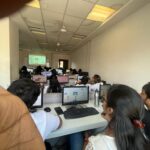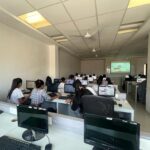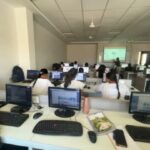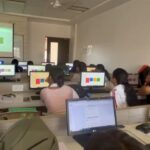|
Members |
Name |
|
Chairperson |
Dr. Priyanka Pandey (Principal) |
|
Co-ordinator |
Asst. Prof. Sanabano Shaikh |
|
Student member |
Ms Kanika Yadav |
While technology can play an important role in restructuring teaching and learning practices, teachers must take a leading role in designing appropriate learning environments that effectively incorporate technology to help their students learn well with technology. Computer technology, as a tools, could empower students with thinking and learning skills, and help students interact with complex materials. However, computers alone cannot realize many educators’ vision for technology to improve education.
Need and Importance of the ICT Cell
Need
- Lifelong Learning: Education is a continuous process, and there is a need for anytime, anywhere access.
- Diverse Learning Needs: IT is essential to meet the needs of a variety of learners.
- Technological Literacy: Society requires all individuals to be technologically literate.
- Access and Cost Efficiency: IT helps increase access to education and reduce costs to combat illiteracy and poverty.
Importance
- Learning Resources: Provides access to a variety of learning resources.
- Information Access: Offers immediacy to information.
- Flexible Learning: Supports anytime and anywhere learning.
- Collaborative Learning: Facilitates collaborative learning experiences.
- Multimedia Education: Utilizes a multimedia approach for more engaging education.
- Up-to-Date Information: Ensures access to authentic and current information.
- Online Libraries: Grants access to online libraries.
- Engaging Teaching: Makes the teaching of different subjects more interesting.
- Educational Data Storage: Enables storage of educational data.
- Distance Education: Supports distance education.
- Information Sources: Provides access to various sources of information.
- Communication Channels: Uses multiple communication channels like email, chat, forums, and blogs.
- Open Courseware: Facilitates access to open courseware.
- Disability Access: Improves access for children with disabilities.
- Efficiency: Reduces time on many routine tasks.
Significance of the ICT Cell
- Impact of IT in Education: Continual developments in IT significantly affect education.
- Change Pace: The rapid change brought about by new technologies influences lifestyles globally.
- Challenge to Traditional Methods: New technologies challenge traditional teaching and learning processes.
- Curriculum Impact: IT has a major impact across all curriculum areas.
ICT Integration at Oriental College of Education & Research
Oriental College of Education & Research integrates ICT into its teaching-learning process and encourages student-teachers to do the same through various activities:
- Online Tests: Conducting online tests.
- Online Quiz Competitions: Hosting online quizzes.
- Faculty Feedback: Collecting feedback online.
- Student-Teacher Forums: Facilitating online forums for interaction.
- Social Media: Maintaining social media handles.
- Smart Boards: Providing hands-on experience with smart boards.
- Open Office: Training on Open Office software.
- Research and Assessment: Utilizing ICT for research and assessment.
- Teacher Development: Using ICT for teacher growth and development.
- Teaching Aids: Developing audio-visual teaching aids.
- e-Learning Resources: Creating e-learning resources.
- e-Libraries: Accessing e-libraries and e-resources.
- ICT Ethics: Understanding the ethics of ICT.
These initiatives ensure that both teachers and students are well-equipped to harness the potential of ICT in education.
















